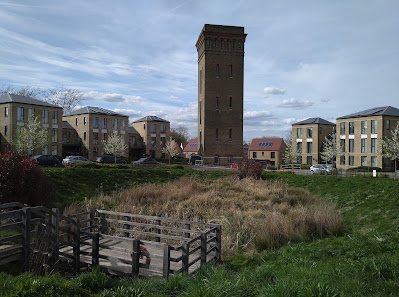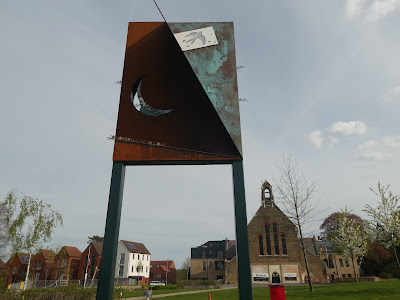A walk around Cane Hill
"It's too late - there's a housing estate
It's called High Royds"
- Kaiser Chiefs - Highroyds
I realise that housing estates built on former hospitals don't fit everyone's definition of beauty, but this is my blog so you'll have to indulge my bizarre interests. I've included some pretty photos including a fox and a cat.
The song Highroyds from the Leeds band Kaiser Chiefs' 2007 album is a look back at their teenage years, testing their courage running around the High Royds asylum opposite the school several band members went to, north of Leeds. Towards the end of the song, in the present day, the band receive word from a relative that the asylum has now been converted into a housing estate. This seems to be the most common fate of former asylums, with typically a few iconic/listed buildings kept and converted and everything else demolished and replaced with modern housing.
Following my previous post about former hospitals and a walk around Netherne-on-the-hill in the Coulsdon area, I visited Cane Hill in April 2022 and started writing this blog post but never finished it. In July 2022, I met Pam Buttrey, a former Occupational Therapist who worked in mental health in South London, including at Cane Hill. She is now a historian who wrote the book Cane Hill Hospital: The Tower on the Hill, which was published in 2010. I was inspired by talking to her about her personal experiences at Cane Hill, her historical research and her views on contemporary mental health treatment. I bought a copy of her book which I've been reading and I'm finding it very interesting, although much of this post was written before that.
 |
| Cane Hill from Farthing Downs, May 2021 |
In the foreground of the photo above you can see the frontage of the former administration block with the incongruous modern additions. Behind this to the is the chapel and behind that, the water tower. To the right you can see some of the new houses.
 |
| Looking towards the Coulsdon Bypass |
Located on a hill (unsurprisingly), Cane Hill is well connected, being just across the A23 Brighton Road from Coulsdon South station and close to Coulsdon town centre, with the M25 just a few miles away. There are views across to Farthing Downs and into central London. It was a rural area when the hospital was first built in the early 1880s. The Victorians had the quite progressive idea that locating asylums in places with fresh air and pleasant surroundings would be good for the patients. The asylums were intended to be somewhat self-sustaining communities, with suitably fit patients employed in farming, catering, the laundry and other areas.
 |
| Memorial to Dr James Moody, the first medical superintendent at Cane Hill |
Click here to view a map from the early 20th century alongside current satellite imagery on the National Library of Scotland website to see the layout and surroundings of the hospital. The hospital was known variously as the Third Surrey County Pauper Lunatic Asylum, Cane Hill Asylum, Cane Hill Mental Hospital and Cane Hill Hospital, as attitudes to mental health gradually evolved during the 20th century. Gradually the hospital came to serve patients from areas of South East London, including Bromley, Lewisham and Southwark, meaning it was quite far from the patients' homes. According to Pam Buttrey (2010), in the years before its closure, most of the patients were elderly and had been there long term and become institutionalised to varying degrees. Due to a chronic lack of investment, the wards were run down and in need of redecoration and there were staff shortages and recruitment problems. The hospital closed in 1992, a bit earlier than other local asylums, although a secure unit continued to operate on part of the site until 2008.
 |
| Administration block redeveloped as housing, April 2022 |
Not a whole lot remains from the hospital. Unfortunately parts of the buildings were destroyed by fires. In 2010, the administration block caught fire and the clocktower was destroyed. The frontage of the administration block remains, with a strange mix of modern additions, some of which don't exactly blend in.
An area of woodland called Dunstan Wood has been retained for recreational use, with some fitness and play equipment, which ensures there are some mature trees on the site.
Like at other former asylums, the water tower has been retained as a centrepiece, although there have been delays in converting it into housing. It's apparently going to be turned into a four bedroom house over seven floors.
In front of the water tower there is a pond, which has steps down to a wooden platform. Due to the amount of foliage in the pond, it's hard to tell how much life there is but I did spot a pond skater and a large number of water snails. The pond could definitely do with a clean though as there is rubbish in it and it is overgrown with duckweed.
In the opposite direction from the water tower, the hospital chapel is also waiting to be redeveloped. It's more the size of a church, although the stained glass windows are more simple than is customary for a church. The chapel apparently held around 800 people (Buttrey, 2010).
 |
| Detail of chapel and new additions, April 2022 |
 |
| Evidence of a demolished building on the side of the chapel |
 |
| A fox relaxing near the memorial to Dr Moody, April 2022 |
 |
| A Roman snail shell, a protected species |
 |
| This local resident looked very relaxed |











Comments
Post a Comment